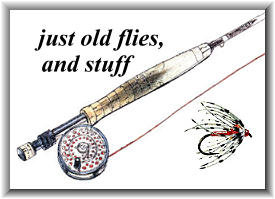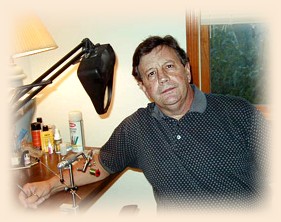

Welcome to 'just old flies,' a section of methods and flies that used-to-be. These flies were tied with the only materials available. Long before the advent of 'modern' tying materials, they were created and improved upon at a far slower pace than today's modern counterparts; limited by materials available and the tiers imagination.
Once long gone, there existed a 'fraternity' of anglers who felt an obligation to use only the 'standard' patterns of the day. We hope to bring a bit of nostalgia to these pages and to you. And sometimes what you find here will not always be about fishing. Perhaps you will enjoy them. Perhaps you will fish the flies. Perhaps?

The Proctor
This cute little fly was brought to mind recently when I heard from reader Kevin Proctor asking if I knew anything about its history. I was able to dig this up from Mary Orvis Marbury's Favorite Flies and Their Histories, in a letter to her from T.P. Proctor:
T.P. Proctor, Utica, N.Y.My fishing is all done at the lakes owned and controlled by the Bisby Club. Having had good success with the Reuben Wood fly, and thinking it might be improved upon, I made some suggestions for the making of it which are embodied in the enclosed fly. Many of my friends have had good luck with it, and they have named it the Proctor fly. I hope you will give it a trial, and let me know what success you have with it.
Note. -The Proctor fly is similar to the Reuben Wood, except that the body is made with chenille of a pale pink tinge tipped with three turns of olive-brown chenille.
The fly is also found in a list of wet flies in Trout Fly Fishing in America by Charles Zibeon Southard, published in 1914. It survives and is listed in J.Edson Leonard's Flies as well, then disappears from the scene.
A little research on the Bisby Club revealed this information, found in Senneca Ray Stoddard's book on the Adirondacks entitled The Adirondacks Illustrated:
The old Bisby Club, with its 25 members, has recently consolidated with the Adirondack League Club, under the name of the latter. The oldest of all the Adirondack clubs joined in interests with the largest! The Bisby Club owned 320 acres and leased many thousand in the Woodhull tract, directly west of the League's great preserve. First Bisby Lake, and the other near waters, are abundantly stocked with fish.
And finally we have this from the Annual Report of the Forest Commission of the State of New York done in 1893:
The club has a large, elegant house on Little Moose Lake, near the Fulton Chain; also a " Forest Lodge " on Jock's or Honnedaga Lake, and the " Bisby Lodge " on Bisby Lake. There are also several cottages on these lakes belonging to members. An annual record of the game and fish killed or taken by members, guests, or guides, is kept at each house, showing the date, name of the member, guest, or guide, number and weight of each species of game killed or fish taken on that day, together with the place, approximately, where such game was killed or fish taken. The lands owned by the club abound with deer and other game, while its waters teem with fish. The preserve may not excel all other localities in this respect, but will certainly compare favorably with any, especially in brook trout.
So my first instincts concerning this fly have been born out. It was created for brook trout fishing undoubtedly, its flagrant pink color the giveaway. Kevin Proctor who originally contacted me about this fly reports that he is indeed related to T.P. Proctor, though only distantly. Kevin, who is relatively new to fly tying, is doing some splendid wet flies from bygone days, indicating to me that these are not quite as hard to tie as I first believed. Or perhaps he's just gifted. Here's the recipe for the Proctor:
Proctor Materials
Credits:
Favorite Flies and Their Histories by Mary Orvis Marbury; Flies by J. Edson Leonard; The Adirondacks Illustrated by Senneca Ray Stoddard; Trout Fly Fishing in America by Charles Zibeon Southard; Annual Report of the Forest Commission of the State of New York by the New York Forest Commission~ EA
About Eric:

Eric lives in Delaware, Ohio and fishes for brown trout in the Mad River, a beautiful spring creek.
More of his flies are on display here: traditionalflies.com -- Classic salmon and trout flies of Europe and the Americas
[ HOME ]
[ Search ] [ Contact FAOL ] [ Media Kit ]